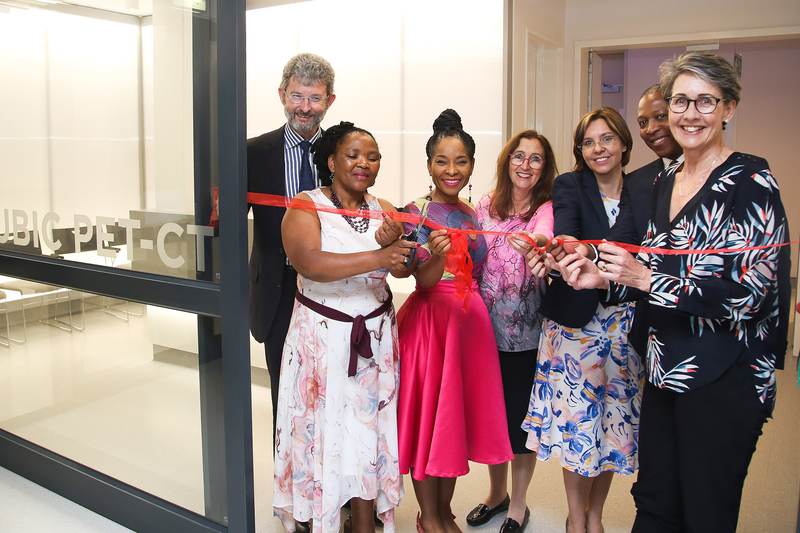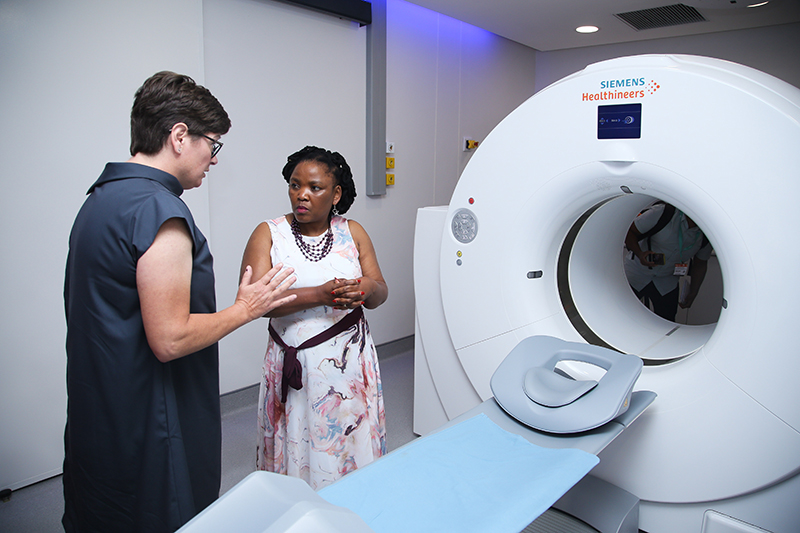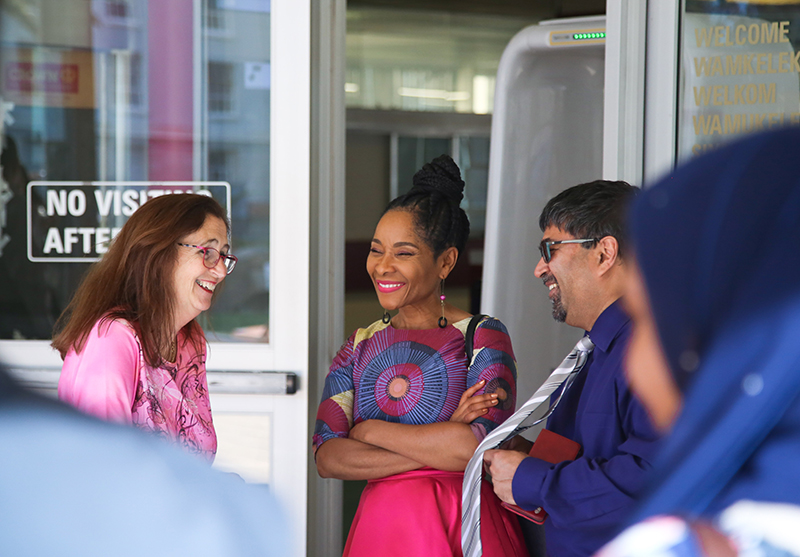PET-CT scanner heralds new era in TB research
14 November 2019 | Story Helen Swingler. Photos Je’nine May. Read time 9 min.
The Cape Universities Body Imaging Centre (CUBIC) launched its Positron Emission Tomography-Computed Tomography (PET-CT) Core Research Facility on Wednesday, 13 November, bolstering capacity in cutting-edge research on tuberculosis (TB), oncology, neurocognitive disorders, cardiovascular and other diseases.
CUBIC is a national imaging facility established through collaboration between UCT, Stellenbosch University, the South African Medical Research Council and Siemens. CUBIC-UCT is one of the Faculty of Health Sciences’ core research facilities.
The new facility is located at the Neuroscience Centre on the UCT and Groote Schuur Hospital (GSH) campus, thanks to GSH chief executive Dr Bhavna Patel. CUBIC PET-CT’s director is Dr Tessa Kotze.
PET is widely considered the most sensitive technique available for non-invasively studying inflammation, physiology, metabolism and molecular pathways in patients. PET-CT is a hybrid imaging method that combines the metabolic information provided by PET imaging with morphological data obtained by CT scan.

The new facility at UCT meets the fast-growing demand for PET-CT scans, particularly for clinical studies in TB – the leading cause of death in South Africa and the leading infectious killer of people worldwide. The scans allow researchers to monitor progression from infection to disease and to provide early indication of the efficacy of new drugs and drug combinations.
The list of indications for the use of PET-CT includes more than 20 different tumours as well as neurological, cardiac, vasculitis, sarcoidosis and infection indications.
Current PET-CT research is looking at refining oncology indications and expanding the indications in neurology, cardiology and infection imaging.
Speaking at the launch, Vice-Chancellor Professor Mamokgethi Phakeng said that most current literature on the clinical use of PET-CT in oncology, neurology and cardiology derived from non-representative populations in developed countries.
With the expansion of PET-CT capabilities, it will be possible to address this, building Africa-based scholarship.
“I expect we’ll see the ripple effects of this new facility across our continent and our world.”
“In many ways, this is a victory,” she said, “not just locally or provincially, but I expect we’ll see the ripple effects of this new facility across our continent and our world.”
Besides benefiting scholarship, the centre will boost capacity development, especially among high-end clinical and technical personnel and emerging researchers.
Dream in waiting
Professor Val Mizrahi, co-principal investigator and director of the Institute of Infectious Disease and Molecular Medicine (IDM), said the former dean, the late Professor Bongani Mayosi, had been passionate about obtaining a PET-CT scanner for the faculty.
As a result of a conversation Mizrahi had at a conference two and a half years ago, she and Professor Mayosi wrote the first grant proposal for the initial tranche of funding from the Bill & Melinda Gates Foundation (BMGF). And the rest, as they say, is history.
The ramifications of the facility for the treatment of TB are considerable. The BMGF invests significantly in the areas of TB research and development. The foundation and other key funders like the Technology Innovation Agency (TIA) and Aspen Holdings, recognise Cape Town as a leading global site for clinical TB research, with world-class TB research groups centred at UCT and Stellenbosch University, CUBIC partners.

The dawn of a new era
The development heralds the dawn of a new era of precision medicine, specifically in the areas of diagnostics and targeted therapy, Professor Ntobeko Ntusi said at the launch. Ntusi is co-principal investigator of this project with Mizrahi and head of UCT’s Department of Medicine.
The facility will allow clinicians to monitor TB’s progression — from infection to disease — and test the efficacy of new drugs and drug combinations.
It will also cement UCT’s role as a global player through collaborations with local and international partners and create historic possibilities for the faculty. It also strengthens partnerships with the Western Cape Department of Health and Stellenbosch University.
“Such collaboration is [a] critical element in Africa’s battle against diseases such as TB. It puts us miles ahead in the kinds of questions we can ask and what we can discover,” Ntusi said.
Enabling environment
Western Cape Minister of Health, Professor Nomafrench Mbombo, said the power of partnerships not only benefited government, but also shared expertise and resources as well as the risks and benefits of the outcomes the facility would bring.
“It shows that universal health is possible through the creation of an enabling environment created through investors who have an appetite to fund research.”
Speaking on behalf of Interim Dean Professor Carolyn Williamson, the deputy dean for research in the Faculty of Health Sciences, Professor Ambroise Wonkam, said the development was long overdue.
Research in the faculty is supported by around R1 billion in grant and contract income annually and represents a major enterprise for the university. Sustainable research support structures were vital to that.
“CUBIC is one of five core research facilities within that structure to enable a specific area of research so that we maintain excellence and sustain our position of strength in research,” she said.
As such, it slots in well with the Vice-Chancellor’s Vision 2030.
History of CT scanner
The launch was also a moment for serendipity, said Professor Graham Fieggen, master of ceremonies and head of the Department of Surgery and director of the Neuroscience Institute.
The CT was first developed by alumnus Allan MacLeod Cormack, co-winner of the 1979 Nobel Prize in Physiology or Medicine for his computer-assisted tomography (CAT) scanner. This not only revolutionised the future of imaging but inspired new generations of medical scientists.
“That work was done at UCT in the 1950s,” said Fieggen.
“When we started refurbishing J Block [at GSH], which is now the Neuroscience Institute, I heard a story that Cormack had worked in that building because the cobalt machine he used for his work was next door.”
 This work is licensed under a Creative Commons Attribution-NoDerivatives 4.0 International License.
This work is licensed under a Creative Commons Attribution-NoDerivatives 4.0 International License.
Please view the republishing articles page for more information.










